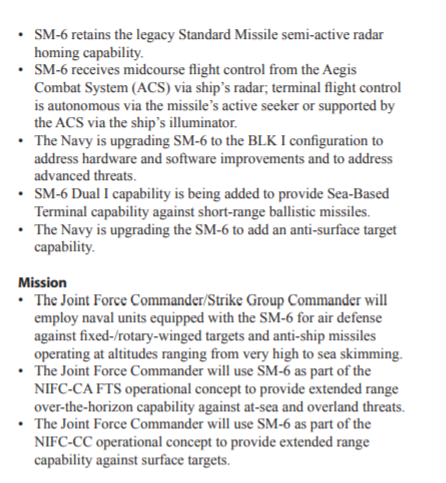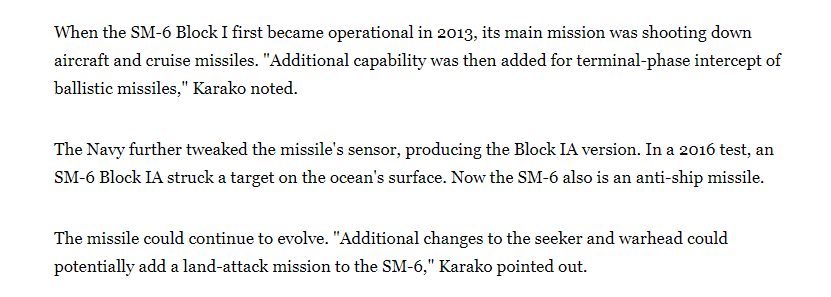Navy engineers are working to bring new aircraft sensors and new weapons into
the Naval Integrated Fire Control-Counter Air (NIFC-CA) architecture, with near-term goals of bringing in the F-35’s radio frequency (RF) sensor and the anti-surface variant of the Standard Missile-6.
In a January test, the Navy proved that the new SM-6 Block I anti-surface missile worked, but it also proved that NIFC-CA – which, as its name implies, was engineered to go after fast-moving air threats – could be adjusted to counter surface threats too.
Whereas a normal NIFC-CA anti-air engagement might use an E-2D Advanced Hawkeye as the sensor that finds a target and then use the Cooperative Engagement Capability (CEC) as the link to bring targeting data to the ship that ultimately fires a weapon,
the anti-surface technology demonstration required some modifications. A different sensor was needed to identify surface targets, and that sensor could not use CEC, meaning the whole engagement relied instead on Link-16, Anant Patel, major program manager for future combat systems in the Program Executive Office for Integrated Warfare Systems, told USNI News in an interview this month.
Patel did not name the sensor used in the demonstration, but the Navy’s P-8A Poseidon, which is equipped with Link-16, or eventually the unmanned MQ-4C Triton would be ideally suited for the job. Patel said NIFC-CA is sensor-agnostic, as long as the sensor meets quality of service standards. But finding weapons that can hit large but slow-moving targets has its challenges.
“When things go slower, it’s easier” to track them, he said.
“But it has its own complexity also. Some of our weapons are not designed to look for slow targets, so we have to do some analysis and make sure we capture that. Also, if you look at SM-6, it’s more an anti-air weapon, so the capability’s designed to counter fast-moving targets, and then to go against this slow-moving target we had to make sure we can meet that requirement.”
Some minor modifications were made to the Aegis Combat System Baseline 9 to accept the data from the new sensor, but Patel said the culmination of this work – a test in January at the Pacific Missile Range Facility in Hawaii – was a successful hit against a surface target, the decommissioned frigate
Reuben James (FFG-57). This success is an early step in fielding a bigger
All Domain Offensive Surface Warfare Capability

 www.navalnews.com
www.navalnews.com












